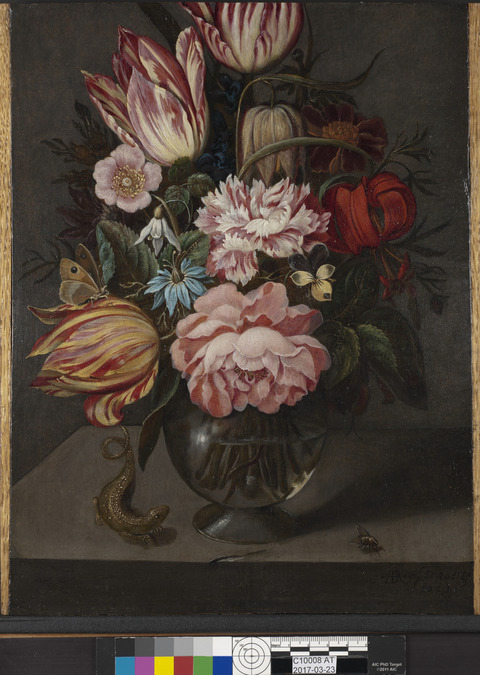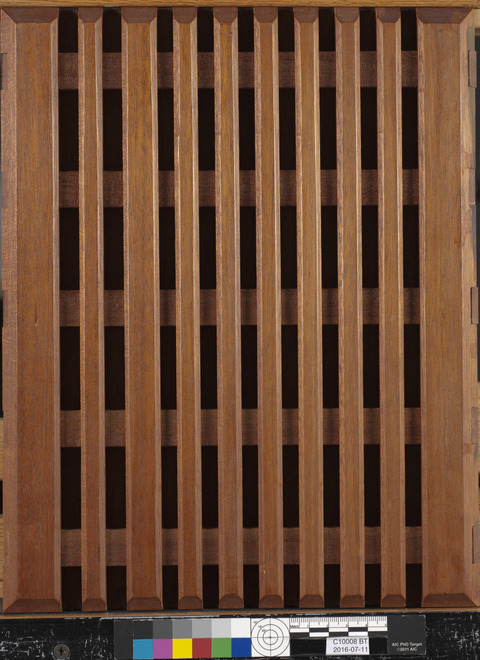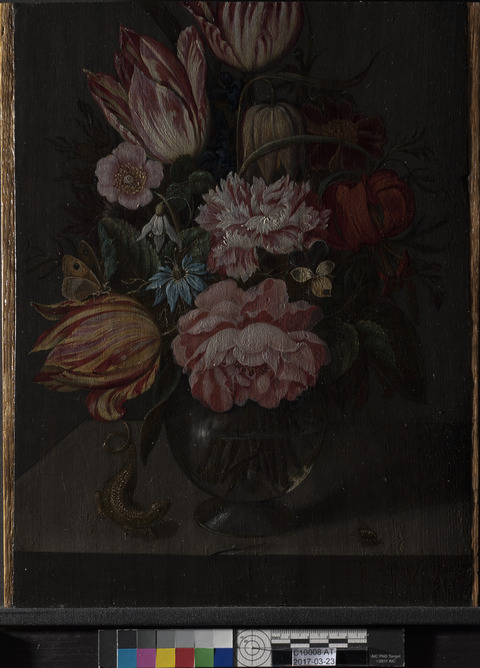Overview
Identification number: 2019.19
Artist: Ambrosius Bosschaert the Younger
Title: Flowers in a Glass Vase
Materials: Oil (untested) on Baltic oak panel
Date of creation: About 1635
Previous number/accession number: C10008
Dimensions:
31.6 × 24.1 cm (original panel)
31.6 × 24.9 cm (panel with cradle and edge strips)
Conservator/examiner: Fiona Beckett
Examination completed: 2016, revised 2021
Distinguishing Marks
Front:
Item 1. Signature and date in black paint, bottom right

Back:
None
Summary of Treatment History
Physical evidence suggests the painting has been previously treated numerous times, though not all of these treatments are documented. Prior to arriving at the Indianapolis Museum of Art (IMA), the painting underwent structural and aesthetic treatments, including trimming of the panel, the addition of a cradle and edge strips, and several conservation campaigns of varnish removal and overpaint application.
Documentation suggests a series of condition assessments and treatments were carried out on the collection around the time the works were moved from the Clowes' residence to the IMA in 1971. A condition report by Paul Spheeris in October of that year, likely carried out before the paintings were relocated, described the painting as having a white line at the top and bottom of both sides next to the frame. He noted that the painting was not in immediate danger but commented that the work suffered from a “heavy natural resin varnish that is creating an undue amount of surface tension that could possibly cause cupping of the paint layer.” He recommended removal of the varnish to remedy this and enhance the appearance of the painting.1 A second condition assessment was carried out upon arrival of the paintings at the IMA. This assessment described the work as in stable condition, and no work was deemed necessary. An X-radiograph of the painting was made at that time.2
The painting was inspected in the Clowes Collection annual survey from 2011 to 2020, examined by Sarah Gowen (Samuel H. Kress Fellow in Paintings Conservation) in 2013, and examined and treated by Clowes Conservator of Paintings Fiona Beckett in 2016. The 2016 treatment involved varnish removal, overpaint reduction, application of a synthetic varnish, fills, and inpainting areas of previous damage. Over the course of the 2016 treatment, the old varnish and overpaint was removed. During the treatment, several notable observations were made, including that damage had occurred at the upper edge of the panel, that a large overpaint campaign had occurred, and that an additional tulip was once present in the composition. The removal of overpaint revealed the additional variegated tulip at the pinnacle of the bouquet, indicating the painting had once been larger.3 In its current conserved state, the painting exhibits the previously hidden, albeit truncated, third tulip.
Current Condition Summary
Structurally, the painting is in good condition. It has remained in a stable environment with very little shift in temperature and relative humidity, and the panel does not show signs of distress. Aesthetically, the painting is in good condition, having been treated in 2016.
Methods of Examination, Imaging, and Analysis
| Examination/Imaging | Analysis (no sample required) | Analysis (sample required) |
|---|---|---|
| Unaided eye | Dendrochronology | Microchemical analysis |
| Optical microscopy | Wood identification | Fiber ID |
| Incident light | Microchemical analysis | Cross-section sampling |
| Raking light | Thread count analysis | Dispersed pigment sample |
| Reflected/specular light | X-ray fluorescence spectroscopy (XRF) | Fourier-transform infrared spectroscopy (FTIR) |
| Transmitted light | Macro X-ray fluorescence scanning (MA-XRF) | Raman microspectroscopy |
| Ultraviolet-induced visible fluorescence (UV) | ||
| Infrared reflectography (IRR) | Gas chromatography–mass spectrometry (GC-MS) | |
| Infrared transmittography (IRT) | Scanning electron microscope -energy dispersive X-ray spectroscopy (SEM-EDS) | |
| Infrared luminescence | Other: | |
| X-radiography |
Technical Examination
Description of Support
Analyzed Observed
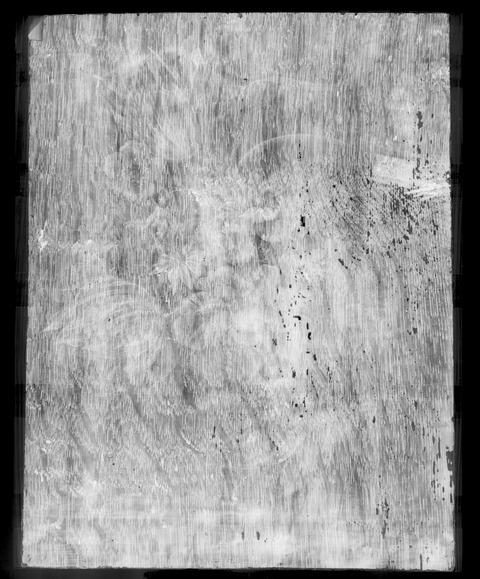
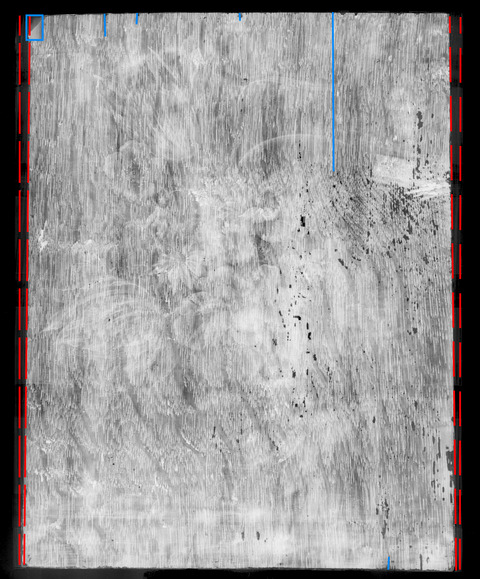
Material (fabric, wood, metal, dendrochronology results, fiber ID information, etc.):
The painting is executed on a single oak panel with vertical grain from the Baltic/Polish region (tech. fig. 2). When viewed from the bottom edge, the rings of the tree can be observed, and the panel appears to be tangentially (although almost radially) cut. Dendrochronology was conducted by Peter Klein. He determined that the youngest heartwood ring was formed in the year 1617. Adding the assumed number of sapwood rings (fifteen) plus two years for seasoning, Klein estimated a terminus post quem of 1634 for the painting.4
Characteristics of Construction / Fabrication (cusping, beveled edges of panels, seams, joins, battens):
The panel was fitted with two edge strips (right and left edges) effectively adjusting the dimensions of the painting into a more rectangular shape. This may have been executed to even out the dimensions of the panel and simplify the addition of the cradle.
Thickness (for panels or boards):
3.5 mm
Production/Dealer’s marks:
None
Auxiliary Support:
Original Not original Not able to discern None
A cradle was adhered to the back with ten fixed vertical members and five movable horizontal members. The two outer fixed members are larger in size than the inner eight members. Additionally, when seen from the back, the third vertical fixed cradle member is also larger, likely to support and cover a crack in the panel. The cradle is well crafted, beveled on the edges, and adhered to the thinned panel with a strong brown adhesive, likely hide glue, which can be seen in some areas along the cradle-panel interface. The edge strips on either side remain unpainted. The back of the thinned panel was sanded and stained.
Condition of Support
The panel is structurally sound overall. It exhibits an older vertical split (approximately 10.5 cm) originating from the top edge, as well as some additional minor splits and checks in the wood. The upper-left corner exhibits a rectangular loss that appears to be cut out of the panel (measuring 0.8 × 1.5 cm), then filled with a different type of wood, as the density is not the same as the oak used for the panel (see tech. fig. 2). The upper edge was significantly trimmed, which removed both the wood and some of the composition. This agrees with the rougher edge and the aforementioned rectangular loss. Previous infestation in the wood created some tunneling and flight holes, which are evident in the X-radiograph, but there is no sign of any current infestation. The cradle is in stable condition, although all five sliding horizontal members have seized due to movement of the panel in response to environmental fluctuations, likely prior to arrival at the IMA.
Description of Ground
Analyzed Observed
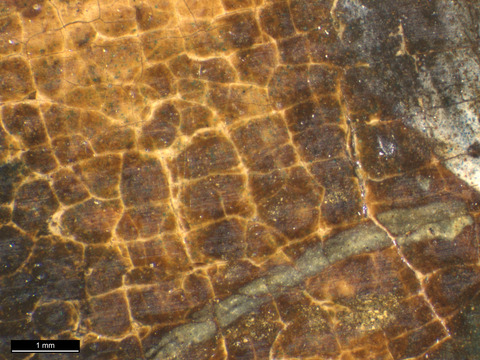
A single, thin layer of off-white ground appears present over the entire surface of the panel and is visible along the edges where there are losses in the paint layers and in the cracks (tech. fig. 3). The ground is uniform in color throughout the panel, as well as uniform in thickness.
Materials/Binding Medium:
Analysis by X-ray fluorescence revealed the presence of lead and calcium throughout the painting, indicating a ground layer consisting of a chalk and lead white mixture. Cross sections indicate a white ground and light gray imprimatura (tech. fig. 4).
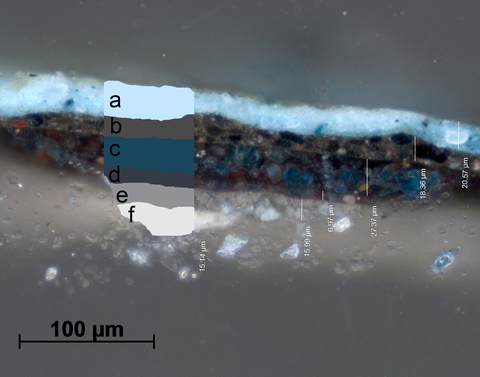
Color:
Off-white
Application:
Likely brush applied
Thickness:
Relatively thin
Sizing:
While difficult to determine without further testing, the panel was likely sized prior to the addition of the ground layer as part of panel preparation technique common in seventeenth-century Holland. The size layer was not seen in the cross-sections.
Character and Appearance (does texture of support remain detectable / prominent?):
The texture of the wood grain remains prominent through the paint layers, except in areas of thicker paint. In the X-radiograph, the wood grain is very prominent. This is due to the ground being composed of a dense paint (such as lead white) that entered the wood structure, accentuating the grain.
Condition of Ground
The ground layer exhibits a cracking network consistent with the wood panel’s natural aging process over time. This is discernible through the paint layers. The adhesion between the ground and the panel support remains strong, as well as that between the ground and the overlying paint layers. Minor losses are present, particularly around the edges, and a few are scattered in the composition, which are noticeable in the X-radiograph along the right half of the painting. These have been retouched during the latest conservation campaign.
Description of Composition Planning
Methods of Analysis:
Surface observation (unaided or with magnification)
Infrared reflectography (IRR)
X-radiography5
Analysis Parameters:
| X-radiography equipment | GE Inspection Technologies Type: ERESCO 200MFR 3.1, Tube S/N: MIR 201E 58-2812, EN 12543: 1.0mm, Filter: 0.8mm Be + 2mm Al |
|---|---|
| KV: | 21 |
| mA: | 3 |
| Exposure time (s) | 90 |
| Distance from X-ray tube: | 36″ |
| IRR equipment and wavelength | Opus Instruments Osiris A1 infrared camera with InGaAs array detector operating at a wavelength of 0.9-1.7µm. |
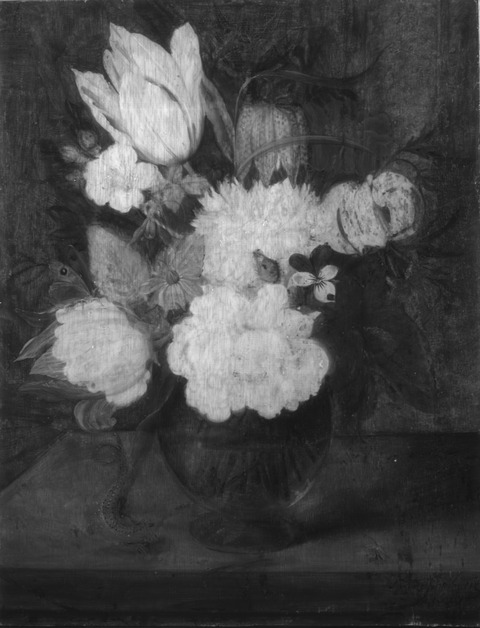
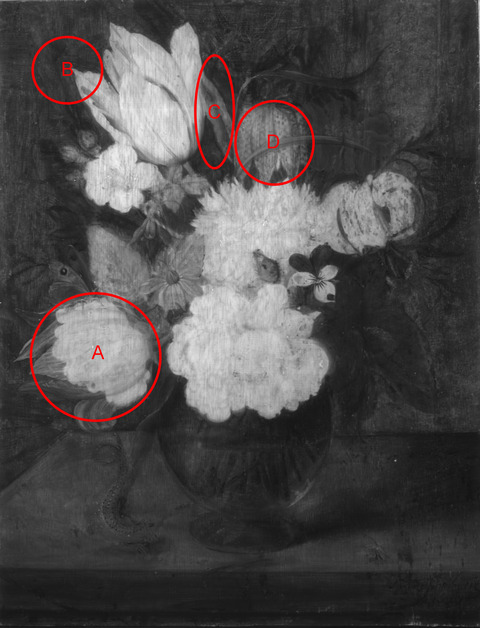
Medium/Technique:
Underpainting can be seen when the painting is imaged with a camera sensitive to infrared. Light lines in some of the flowers also suggest some initial composition planning done in a dry medium as well.
Pentimenti:
There are several areas of pentimenti present in the painting along with minor adjustments and refinements. Most prominently, the lower-left tulip was originally painted as a second French rose. The infrared image shows bright white petals similar to the larger, more central French rose (see tech. fig. 5). The flower was later altered and changed to a variegated tulip, though it kept its more bulbous form. The upper-left tulip was slightly adjusted around the edges to give more definition to the petal; the infrared image shows the gray layer was reworked to cover the excess. To the right of the upper tulip are blue hyacinths that were previously only a single blade of greenery. Finally, in the Iberian fritillary, the dotted design can be seen much more clearly in the infrared.
Description of Paint
Analyzed Observed
Application and Technique:
The paint appears to have been applied in layers, with most of the paint applied wet over dry to create definitive lines of paint over the flowers and intricate details (see tech. fig. 6). Some areas, however, are characteristic of wet-in-wet paint application, for example in the blue flowers (see tech. fig. 7). Most of the paint was applied in small brushstrokes to render the details of the flowers, lizard, and fly. The gray background color was painted initially and appears beneath the outer edges of flowers, but it is difficult to ascertain whether the gray layer is over the entire panel. The gray background was later reworked in some areas, as noticeable in the infrared image, to adjust the edges of some of the flowers.
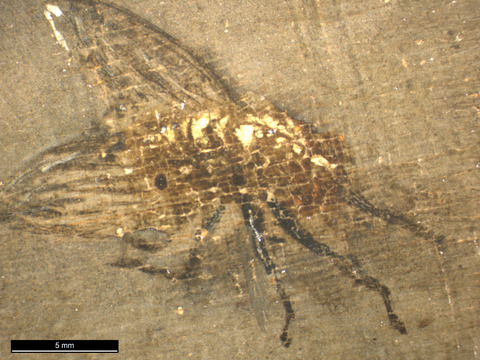
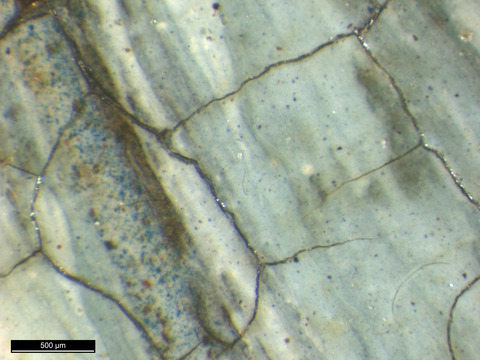
Painting Tools:
Larger brushes were used for the background and initial layers, while smaller brushes were used for the flowers and during the addition of minute details. The markings on the lizard’s back appear to have been added with a harder tool, such as the blunt end of a paintbrush.
Binding Media:
Likely linseed oil, though more analysis is necessary to confirm
Color Palette:
The color palette comprises a gray background with brighter colors for the flowers, including reds, white, greens, blues, and yellows. Earth tones were used to soften excessive vibrance, and black was added to create the shadows on the leaves. X-ray fluorescence was conducted to determine which elements are present. The results indicate that lead is present throughout the painting, likely as lead white used in the ground layer and possibly red lead in the red passages. This is consistent with the X-radiograph, which shows a dense material present over the entire painting and into the wood rays. Likely the ground layer also contained glue and calcium carbonate. Calcium was also present in much of the painting. It appears that red lead was used for the turban cap lily, along with traces of vermilion, as lead and mercury were both detected in this area. Iron oxides such as yellow ocher and red earth were used, as well as copper-containing pigments such as malachite and azurite.
XRF Analysis:
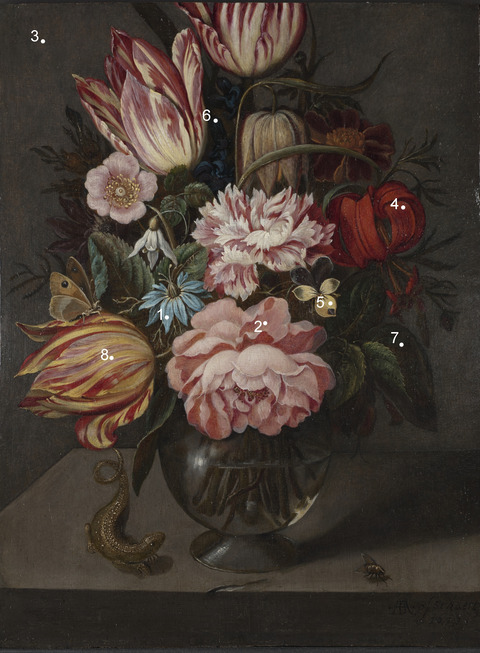
| Sample | Location | Elements | Possible Pigments |
|---|---|---|---|
| 1 | Blue in lady of the mist flower | Major: Cu, Pb Minor: Trace: Fe, Ca | Azurite, lead white, traces of iron oxide (earth pigments), calcium |
| 2 | Yellow in French rose piston | Major: Pb Minor: Fe, Ca Trace: Cu, Mn, Ti, K, Zn | Lead white, iron oxide (earth pigments including yellow ocher), calcium (possibly from ground), traces of azurite or malachite, umber, titanium (overpaint or impurity), potassium, zinc (overpaint or impurity) |
| 3 | Gray background top left | Major: Pb Minor: Fe Trace: Ca, Mn, Ti, Cu | Lead white, iron oxide (earth pigments including umber), traces of calcium (possibly from ground), possible carbon black (not confirmed using XRF), titanium (impurity or overpaint) and azurite or malachite |
| 4 | Red in turban cap lily on right | Major: Pb Minor: Ca, Fe, Cu Trace: Hg, Ba, Mn, K, Zn, Sn | Lead white, red lead, calcium (possibly from ground), iron oxide (earth pigments), azurite or malachite, traces of vermilion, barium (likely impurity or overpaint), umber, potassium, zinc (overpaint or impurity), lead-tin yellow |
| 5 | Yellow in Pansy | Major: Pb Minor: Ca, Fe Trace: Sn, Cu, Zn | Lead white, calcium (possibly from ground), iron oxide (earth pigments), traces of lead-tin yellow, azurite or malachite, zinc (impurity or overpaint) |
| 6 | Dark blue in hyacinth | Major: Pb, Fe Minor: Ca Trace: Cu, Hg, K, Ti, Zn | Lead white, iron oxide (earth pigments), calcium (possibly from ground), traces of azurite or malachite, vermilion, potassium, titanium (overpaint or impurity), zinc (overpaint or impurity) |
| 7 | Green in leaf, right | Major: Pb, Cu, Ca Minor: Fe Trace: Cr, Ti, Mn, K | Lead white, azurite or malachite, calcium (possibly from ground), iron oxide (earth pigments), traces of chromium, titanium (overpaint or impurity), manganese (umber), potassium |
| 8 | Yellow in variegated tulip, lower left | Major: Pb Minor: Ca, Fe Trace: Sn, Cu, Hg, Mn | Lead white, calcium (possibly from ground), iron oxide (earth pigments), traces of tin (lead-tin yellow), azurite or malachite, vermilion, umber |
Table 1: Results of X-ray fluorescence analysis conducted with a Bruker Artax microfocus XRF with rhodium tube, silicon-drift detector, and polycapillary focusing lens (~100μm spot).
*Major, minor, trace quantities are based on XRF signal strength not quantitative analysis.
Surface Appearance:
The paint does not exhibit many areas of impasto. However, due to the buildup of layers on the panel, the edges of the flowers and greenery have a slight relief effect when the painting is viewed with specular light.
Condition of Paint:
The paint is in good condition. Lead soaps are present in some areas, suggesting that lead was used in the ground layer or at least in many areas of the painting. The cracking network originating from the ground is also present in the paint layer. Inpainting of areas of loss is present in minor amounts throughout and more extensively in the newly discovered uppermost tulip from the 2016 treatment.6
Description of Varnish/Surface Coating
Analyzed Observed Documented
| Type of Varnish | Application |
|---|---|
| Natural resin | Spray applied |
| Synthetic resin/other | Brush applied |
| Multiple Layers observed | Undetermined |
| No coating detected |
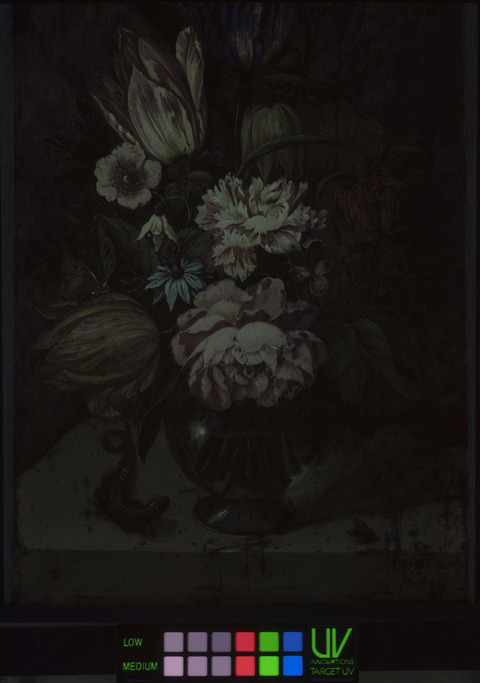
A synthetic resin varnish (Paraloid B72 and a final coat of MS2A) is present on the surface of the painting, as indicated in the 2016 treatment report. Inpainting from the 2016 treatment is present in areas of loss and in the uppermost tulip area that was extensively abraded. Inpainting was executed with AYAA:AYAC (2:1) in 1-methoxy-2-propanol and dry pigments (tech. fig. 9).
Condition of Varnish/Surface Coating
The varnish and inpainting are in excellent condition, having been applied in 2016.
Description of Frame
Original/first frame
Period frame
Authenticity cannot be determined at this time/ further art historical research necessary
Reproduction frame (fabricated in the style of)
Replica frame (copy of an existing period frame)
Modern frame
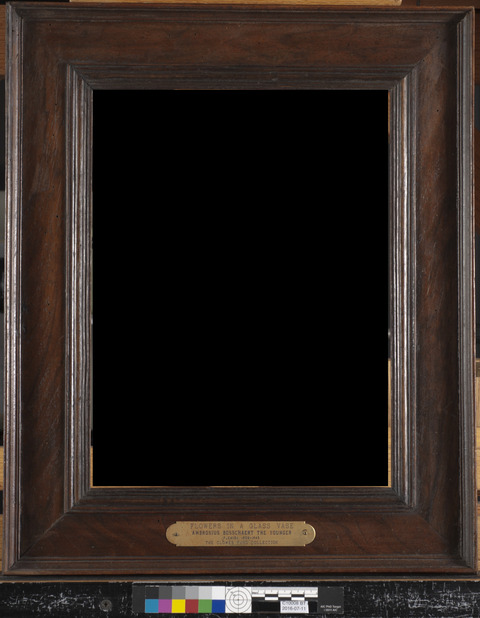
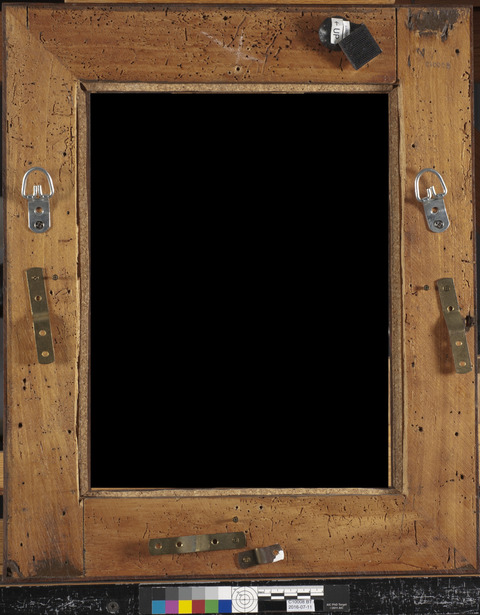
Frame Dimensions:
Outside frame dimensions: 43.5 × 36 × 2.8 cm
Sight Size: 36 × 23.2 cm
Distinguishing Marks:
None
Description of Molding/Profile:
The frame comprises four members with mitered corners when viewed from the front (tech. fig. 10), and both mitered and half-lap when viewed from the back (tech. fig. 11). It appears to have been cut down and resized to fit the current painting. The front is covered with a dark brown wood veneer. The frame is not entirely square and was fitted to the painting’s dimensions (including the two edge additions).
Condition of Frame
The frame is structurally sound and in good condition. Previous infestation from woodworms left tunneling and flight holes, but no infestation is currently active.
Notes
-
Paul A.J. Spheeris, “Conservation Report on the Condition of the Clowes Collection,” 25 October 1971, Conservation Department Files, Indianapolis Museum of Art at Newfields. ↩︎
-
Martin Radecki, Clowes Collection condition assessment, undated (after October 1971), Conservation Department Files, Indianapolis Museum of Art at Newfields. ↩︎
-
Fiona Beckett and Greg Smith. “Restoring a ‘Broken’ Tulip: Analysis-Informed Conservation Treatment of Ambrosius Bosschaert’s 17th-Century Floral Still Life,” Conservation 360 2 (2020). ↩︎
-
The oak panel (31.3 × 23.4 × 24.2 cm) contains 223 growth rings and could be dated between the years 1617 and 1395. Peter Klein, dendrochronological analysis report, C10008 (2019.19), 1999, Conservation Department Files, Indianapolis Museum of Art at Newfields. ↩︎
-
Elvacite 2040 (synthetic resin) was used to fill the cradle so that its appearance would be minimized in the X-radiograph, allowing the composition to be better interpreted. ↩︎
-
Fiona Beckett and Greg Smith. “Restoring a ‘Broken’ Tulip: Analysis-Informed Conservation Treatment of Ambrosius Bosschaert’s 17th-Century Floral Still Life,” Conservation 360 2 (2020). ↩︎
Additional Images
